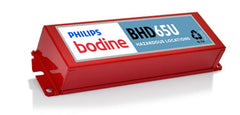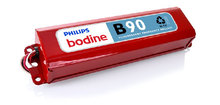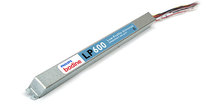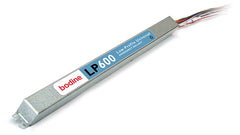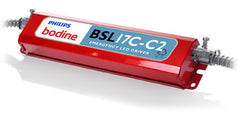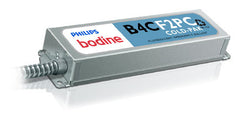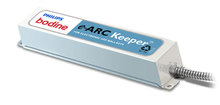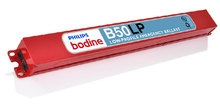- For damp locations
- Two-hour emergency illumination
- End-of-lamp-life compatible
- Illumination Time: 90 minutes (standard), 120 minutes (One 17-32 W T8, One 20-40 W T10 or T12)
- Initial Light Output: 600 - 700 Lumens
- Full Warranty: 3 Years (NOT pro-rata)
- Dual Input Voltage: 120/277 VAC, 60 Hz
- AC Input Current: 280 mA
- AC Input Power Rating: 3.5 Watts
- Test Switch: Single Pole
- Recharge Time: 24 Hour
- Dimensions: 9.4” x 2.4” x 1.5”
- Weight: 2.5 lbs. (1.13 kg)
SPECIFICATION
Emergency lighting shall be provided by using a standard fluorescent fixture equipped with a Philips Bodine B70A emergency ballast. This emergency ballast shall consist of a high-temperature, maintenance-free nickel-cadmium battery, charger and electronic circuitry contained in one 9 3/8” x 2 3/8” x 1 1/2” red metal case. A solid-state charging indicator light to monitor the charger and battery, a single-pole test switch and installation hardware shall be provided. The emergency ballast, using a patented circuit, shall delay AC ballast operation for approximately three seconds to prevent false tripping of AC ballast end-of-lamp-life shutdown circuits. The emergency ballast shall be capable of operating one 17 - 215 W (2’ - 8’) T8, T10 or T12 or (4-pin) long compact at reduced illumination in the emergency mode for a minimum of 90 minutes or one 17 - 32 W T8 or one 17 - 40 W T10 or T12 at reduced illumination in the emergency mode for a minimum of 120 minutes. It shall be suitable for indoor and damp locations and for sealed & gasketed fixtures, including fixtures rated for wet locations. The B70A shall have 3.5 Watts of input power and a 14.4 Watt-hour battery capacity and shall comply with emergency standards set forth by the current NEC. The emergency ballast shall be UL Listed for installation inside, on top of or remote from the fixture and shall be warranted for a full three years from date of purchase.
OPERATION
When AC power fails, the B70A immediately switches to the emergency mode, operating one lamp at a reduced lumen output for a minimum of 90 minutes. Two-hour duration may be selected with one 17 - 32 W T8 or one 20 - 40 W T10 or T12 fluorescent lamp. When AC power is restored, the emergency ballast automatically returns to the charging mode and, using a patented circuit, delays AC ballast operation for approximately three seconds to prevent false tripping of the AC ballast endof-lamp-life shutdown circuits.
INSTALLATION
The B70A does not affect normal fixture operation and may be used with either a switched or unswitched fixture. If a switched fixture is used, an unswitched hot lead must be connected to the emergency ballast. The emergency ballast must be fed from the same branch circuit as the AC ballast. The B70A may be installed inside, on top of or remote from the fixture. The emergency ballast may be remotely installed up to half the distance the AC ballast manufacturer recommends remoting the AC ballast from the lamp or up to 50 feet, whichever is less. Installation is not recommended with fixtures where the ambient temperature may fall below 0°C





